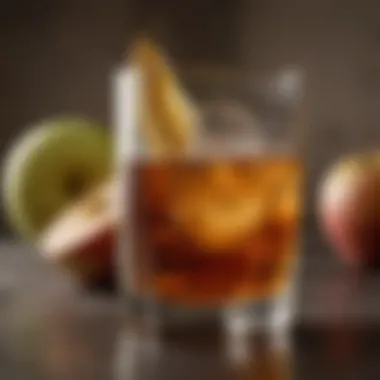The Convergence of Flavors: Whisky Apple Cider Cocktails


Intro
The whisky apple cider cocktail has garnered attention for its ability to combine two seemingly distinct flavors into a harmonious drink. Understanding this beverage requires delving into its history and the unique ingredients that make it special. Its emergence reflects evolving tastes, with a growing appreciation for both whisky and cider in contemporary drinking culture.
This section outlines an overview of the whisky apple cider cocktail, offering insights into its preparation and significance in a social context. We will also explore different variations that are informed by personal taste and regional influences. As we progress, readers will gain a deeper knowledge of why this cocktail appeals to diverse palates and its place in modern mixology.
Preamble to Whisky Apple Cider Cocktails
The whisky apple cider cocktail combines two distinct flavors into a harmonious drink. Understanding this cocktail involves appreciating its complexity and the careful selection of its ingredients. The discovery of the interplay between whisky and apple cider demonstrates how diverse flavor profiles can blend to create an elevated drinking experience. This article endeavors to detail the various aspects surrounding this cocktail, guiding readers through its history, key ingredients, and preparation methods.
Defining the Cocktail
A whisky apple cider cocktail is, at its core, a fusion of malt and fruit, resulting in a drink that is both refreshing and robust. Typically, whisky serves as the base spirit, while apple cider adds a touch of sweetness and tartness. These two elements come together to create layers of flavors. The cocktail can be served in different variations, but the fundamental components remain the same.
Cocktails made with whisky and apple cider can incorporate additional elements like spices or sweeteners. This versatility allows for unique interpretations. Each rendition may highlight different characteristics of the whisky or cider used. Understanding these definitions is essential for crafting the perfect drink.
Historical Context of Whisky and Cider
To appreciate the whisky apple cider cocktail, one must consider the historical backgrounds of its foundational components. Whisky has deep roots, originating in Ireland and Scotland several centuries ago. It evolved through various processes and regions, leading to distinct types that characterize today's offerings. The methods of distillation and aging have transformed whisky into a sophisticated spirit enjoyed worldwide.
Apple cider has its own rich history, tracing back to ancient times. Historical texts indicate that apple cultivation dates back to the Roman Empire. The fermentation of apples into cider likely followed not long after. In various cultures, cider has served as a staple beverage. Therefore, the combination of whisky and cider is not arbitrary; it reflects cultures that appreciate complex flavors.
Together, whisky and apple cider represent two traditions that have stood the test of time. Their convergence in a cocktail speaks to evolution, where past practices inform contemporary applications. The cocktail itself is not merely a drink but a narrative of cultural significance, making it a topic worthy of exploration.
Key Ingredients and Their Characteristics
The whisky apple cider cocktail is defined by its core ingredients: whisky and apple cider. Understanding these ingredients is crucial for crafting a cocktail that balances the flavors effectively. Each ingredient carries distinct characteristics that enhance the overall experience. A careful selection of both whisky and cider can create an exceptional drink that meets the expectations of any discerning palate. Here, we will analyze each key component in detail, as well as their unique features and roles in this cocktail.
Understanding Whisky
Types of Whisky
Whisky comes in several varieties, most of which offer unique profiles that shape the cocktail's character. There are Scotch, Irish, bourbon, and rye whiskies, each from different regions and with their distinct production methods.
- Scotch Whisky: Made from malted barley, known for its smoky and peaty notes, particularly from regions like Islay.
- Irish Whiskey: Typically triple distilled with a smoother finish; it often leans toward sweet and fruity flavors.
- Bourbon: Made primarily from corn, bourbon is sweeter and has rich caramel and vanilla notes.
- Rye Whiskey: Known for its spicy and fruity complexity, rye whiskey adds a bold character.
Choosing the right type of whisky is essential as it affects the drink's flavor, aroma, and overall appeal. Bourbon’s sweetness may harmonize beautifully with apple cider, while rye can add an unexpected spice that delights.
Flavor Profiles
Each type of whisky presents a unique flavor profile that impacts the cocktail. Understanding these profiles helps in selecting the most suitable whisky for your drink.
- Bourbon: Rich, sweet, and full-bodied with vanilla and caramel notes.
- Scotch: Can be smoky, peaty, or fruity depending on the type, providing depth and character.
- Irish: Often smooth and creamy with hints of honey and orchard fruits.
- Rye: Offers spiciness with flavors of citrus, nutmeg, and even mint.
The distinctive characteristics of these profiles influence how well they mix with apple cider. A bold rye can balance the sweetness of cider, creating a complex layering of flavors, while a smooth Irish can provide a refreshing finish.
The Role of Apple Cider


Types of Apple Cider
Apple cider, often used in the cocktail, comes in several forms, each affecting the drink differently. Traditional cider is usually unfiltered and boasts a broader range of flavors.
- Sweet Cider: More sugary and often pulpy, sweet cider is delightful in cocktails where sweetness is desired.
- Dry Cider: Provides a crisp effervescence with a less sugary taste, perfect for balancing richer whiskies.
- Sparkling Cider: Adds a refreshing fizz, which can lighten heavier spirits for a more accessible drink.
Selecting the appropriate variety of cider complements the whisky's attributes. Dry ciders work well with smoky whiskies, creating a contrast that is intriguing.
Seasonality and Freshness
The freshness and seasonality of the cider play vital roles in the choice of ingredients. Fresh cider, typically from local orchards, captures the essence of the season, often offering complex, nuanced flavors. Seasonal ciders exhibit variations in flavor profiles, depending on the apples used and their harvest time.
- Local and Fresh: Using freshly pressed apples adds vibrancy and depth, elevating the taste of the cocktail.
- Seasonal Flavors: Strongly influenced by the time of year, many ciders highlight spices and other flavors relevant to the season, such as cinnamon in fall.
Preparation Techniques
Preparation techniques play a crucial role in the overall creation of whisky apple cider cocktails. These methods not only influence the texture and flavor but also enhance the presentation of the drink itself. Understanding the various techniques can lead to better results and a more enjoyable drinking experience. Selection between shaking and stirring can affect not just the cocktail's character, but also how the elements blend together. Likewise, garnishing and proper glassware enhance both aroma and visual appeal, making the cocktail inviting and sophisticated.
Mixing Methods
Shaking
Shaking is a common technique used in cocktail preparation, especially when mixing ingredients that vary in density. This method creates a frothy texture, allowing the components to blend uniformly. A key characteristic of shaking is its ability to chill the cocktail rapidly, which is especially beneficial for refreshing drinks. In the context of a whisky apple cider cocktail, shaking can help marry sharp notes of whisky with the sweetness of cider and other ingredients.
The unique feature of shaking is the introduction of air, which can enhance flavors and create a lively mouthfeel. However, an excessive shake can dilute the drink, overpowering the subtle nuances. Therefore, timing and technique are essential in achieving the desired balance in flavor and temperature.
Stirring
Stirring is considered a gentler method compared to shaking. This technique is mainly used for cocktails that contain all spirits. One specific aspect of stirring is that it allows for precise control over the dilution and temperature. For whisky apple cider cocktails, stirring maintains the integrity of the flavors while achieving a cool and smooth finish.
The key characteristic of stirring is its ability to produce a silky texture without frothing. This method is advantageous when the cocktail ingredients are already chilled. A unique feature of stirring lies in its simplicity, which makes it an attractive method for home bartenders. However, it can be less effective for fully integrating ingredients with differing viscosities.
Garnishing and Presentation
Herbs and Spices
The incorporation of herbs and spices can elevate a whisky apple cider cocktail significantly. They are not just for visual appeal, but also play a role in flavor enhancement. Fresh herbs like mint or thyme can add layers of complexity and aroma. The key characteristic of using herbs and spices is their ability to create contrasts, balancing the sweetness of cider and the boldness of whisky.
A unique advantage of adding herbs is that they can be customized to fit different occasions and flavors. Some might argue that excessive use can lead to overwhelming flavors, but a careful selection can create a delightful harmony. Selecting the right herb or spice is essential for crafting a memorable cocktail.
Glassware Selection
The choice of glassware significantly contributes to the overall cocktail experience. Different types of glassware can impact the aesthetic and drinking experience. For whisky apple cider cocktails, a highball or rocks glass can be ideal as they allow for layered presentation and easy access to flavors.
A main characteristic of appropriate glassware is its ability to support the cocktail's cooling and aeration aspects. A unique feature is how different shapes can influence the aroma, altering the drinker's perception. While a beautifully selected glass enhances the experience, poor choices can detract from the cocktail's appeal. Ensuring that the glass complements the cocktail is essential for achieving the best results.
Flavor Pairing Considerations


Flavor pairing is essential when discussing whisky apple cider cocktails. The union of these two beverages represents a harmonious blend that can transform a simple drink into a remarkable experience. Understanding how different flavors interact can significantly enhance or detract from the overall tasting journey. Therefore, careful consideration of complementary tastes and seasonal notes is crucial.
Complementary Flavors
Sweet vs. Savory
In whisky apple cider cocktails, the balance between sweet and savory is a pivotal consideration. Sweetness can be derived from the apple cider, complemented by the natural sugars present in certain whiskies. Whisky, especially those aged in charred barrels, offers caramel and vanilla notes. These characteristics work well together, creating complexity in flavor. On the other hand, savory elements, such as herbs or spices, can introduce a layer of depth.
This combination creates a more dynamic drinking experience. The key aspect of sweet versus savory lies in its versatility. Sweet tends to be more approachable; it draws in novice drinkers, while savory appeals to refined palates. Together, they create a broad spectrum of tasting notes that can cater to a diverse audience.
While sweet flavors excel in creating initial appeal, the disadvantage is that they can overwhelm if not adequately balanced. This makes thoughtful pairing critical in maintaining drink quality.
Additional Ingredients
Additional ingredients also hold considerable importance in the whisky apple cider cocktail landscape. Items such as ginger, cinnamon, or even citrus can elevate the flavor profile. Ginger adds warmth and a slight heat that can contrast beautifully with the sweetness of apple cider. Cinnamon, frequently associated with fall, reinforces thematic connections and can enhance the drink's overall aromatic experience.
The inclusion of these additional ingredients can accentuate the unique feature of the cocktail by introducing layers of complexity. They are popular choices as they can either enrich or lighten the drink. However, caution is advised as overcomplicating a recipe can dilute the core essence of the whisky and cider combination.
Seasonal and Thematic Pairings
Seasonal and thematic pairings serve as vital guidelines in crafting the ideal whisky apple cider cocktail experience. These pairings relate directly to the context and environment in which the drink is served. They can elevate the overall experience significantly, reinforcing the cocktail’s ambiance.
Fall Gatherings
Fall gatherings present a natural setting for whisky apple cider cocktails. This season brings an abundance of apples, making fresh apple cider readily available. The crisp air and colorful foliage create an inviting backdrop for enjoying these cocktails. Moreover, these gatherings often focus on warmth, comfort, and togetherness, aligning perfectly with the rich, warming flavors of whisky.
The unique feature of fall gatherings is the opportunity to showcase seasonal themes. The cocktails can include spices reminiscent of holiday cooking, like nutmeg or allspice. This makes them not only delightful but also deeply resonant with audiences celebrating autumn traditions.
Festive Occasions
Festive occasions, such as holidays or large family gatherings, also provide an excellent opportunity to enjoy whisky apple cider cocktails. The celebratory spirit during these times makes a cocktail that is both refreshing and satisfying an attractive choice. The rich flavors of whisky and the sweetness of cider can be tailored to enhance the festive mood.
The key characteristic of these occasions is their universality. People of various backgrounds and tastes can appreciate them. This broad appeal makes whisky apple cider cocktails an effective choice for toasting special moments. However, it is crucial to keep in mind the potential for overindulgence, which can detract from the gathering experience.
In summary, careful consideration of flavor pairings and seasonal context can enhance the experience of whisky apple cider cocktails, making them more than just drinks but conduits for connection and enjoyment amidst diverse tastes.
Exploring Variations and Innovations
Delving into variations and innovations offers insight into how whisky apple cider cocktails have transformed over time. These cocktails have adapted to changing tastes and preferences, allowing both seasoned drinkers and newcomers to appreciate the beverage in new and exciting ways. With the popularity of craft cocktails on the rise, the exploration of unique twists is particularly relevant. Not only does this showcase creativity among mixologists, but it also provides enthusiasts with opportunities for personal interpretation.
Contemporary Twists
Infused Whiskies
Infusing whisky involves steeping various flavors in the spirit to create a distinct flavor profile. This approach enhances the depth of the cocktail, allowing for unique variations tailored to individual tastes. Infused whiskies can include anything from fruits and spices to herbs. The key characteristic of these infused spirits is their ability to enhance the base whisky, adding complexity.
Infused whiskies have gained popularity for their versatility and the personal touch they bring to cocktails. For instance, a cinnamon-infused whisky can add warmth to a cider cocktail, making it especially appealing during colder months. However, there are advantages and disadvantages. While infused whiskies can provide delightful flavors, they may also overpower the delicate balance of the cocktail if not used judiciously.


Complex Syrups
The use of complex syrups further enriches the whisky apple cider cocktail experience. These syrups are crafted using sugars combined with various flavor infusions, such as ginger, vanilla, or even spiced elements. The distinctive characteristic of complex syrups is their ability to envelop the drink in flavor without overwhelming the main ingredients. They can enhance sweetness or provide a tangy kick, depending on the chosen syrups.
Complex syrups are becoming a popular choice because they offer simplicity and efficiency in mixing cocktails. They allow one to experiment with flavors easily, creating a richer and more diverse drinking experience. However, one must be cautious with the sweetness level. Using overly sweet syrups can lead to an imbalanced cocktail, overshadowing the quality of the whisky and cider.
Bartender Creations
The creativity of bartenders plays a significant role in the evolution of the whisky apple cider cocktail. Many mixologists are exploring new ways to combine flavors, often using local ingredients or seasonal items. Their innovations lead to a continuous refreshment of the cocktail landscape.
From recipes featuring exotic spices to unique serving methods, bartender creations often push boundaries. This not only keeps the drink relevant but also invites patrons to discover unfamiliar tastes. Emerging trends may even include the use of sustainable practices, highlighting a deeper connection between cocktails and the environment.
In summary, variations and innovations ensure that whisky apple cider cocktails remain dynamic. Through the incorporation of infused whiskies and complex syrups, along with the inventive touch of talented bartenders, these cocktails offer both tradition and evolution in the glass.
Cultural Significance of Whisky and Cider
The cultural significance of whisky and cider stretches across regions and histories, forming a rich tapestry of traditions and social rituals. Each sip of a whisky apple cider cocktail is not just a moment of indulgence; it’s an invitation to explore the stories behind these beverages, from their geographical roots to their role in contemporary society. Understanding their significance encapsulates recognition of the craftsmanship involved and the connection to heritage.
Regional Variations
Whisky and cider both exhibit a diversity that reflects their origins. For example, Scotch whisky has its own distinct profile with peatiness and smokiness, representative of the Scottish landscape. Alternatively, Bourbon from the United States presents sweeter vanilla notes, owing to its production process involving charred oak barrels. Cider, too, varies greatly by region. Traditional British ciders differ from the sparkling varieties popular in France. The use of local apple types contributes to the unique taste and character of each cider. These regional nuances often inform how whisky apple cider cocktails are made and enjoyed, creating an experience that resonates with local culture.
The Cocktail in Social Settings
In social settings, whisky apple cider cocktails often serve as focal points, promoting dialogue and connection. These cocktails bring a sense of warmth, particularly during autumnal gatherings or festive celebrations. They embody the spirit of hospitality, as hosts often take pride in crafting unique blends that reflect their tastes while honoring traditional recipes. The act of mixing these drinks can stimulate conversations about preferences and variations, creating shared experiences among guests.
"Cocktails are more than drinks; they are a medium of connection in social gatherings."
Moreover, whisky apple cider cocktails have adapted well to modern social trends. They feature prominently in themed events and craft cocktail bars, drawing an audience eager for innovative takes. Here, classic fervor meets inventive flair, enhancing their presence in contemporary culture. Whether at a casual gathering or a formal affair, these cocktails bridge gaps and foster relationships among individuals from varied backgrounds.
Closure and Future Trends
As we conclude our exploration of whisky apple cider cocktails, it becomes clear these beverages offer a unique blend of flavors and cultural significance. The combination of whisky and apple cider is not merely a trend; it reflects a deeper appreciation for craftsmanship in mixology. This article highlights the importance of understanding both ingredients and methods to create an exceptional drinking experience.
In this rapidly changing landscape of cocktails, it’s essential to recognize the evolving preferences of consumers. The increasing popularity of both whisky and craft cider indicates a larger trend towards high-quality, locally-sourced ingredients in mixology. As more drinkers seek to understand what goes into their cocktails, knowledge around these ingredients becomes invaluable.
Recapping the Whisky Apple Cider Experience
The experience of enjoying a whisky apple cider cocktail is multifaceted. It’s not just about the flavors; it's also about the stories behind each ingredient. Whisky, with its varied profiles, combines perfectly with the sweetness and acidity of apple cider. Together, they create a drink that appeals to both casual sippers and discerning aficionados.
Key points to remember include:
- Ingredient Quality: Opting for high-quality whisky and fresh cider elevates the drink.
- Preparation Technique: The method of mixing can influence the overall taste and presentation.
- Personalization: Adaptations in flavor can cater to individual preferences, making each cocktail unique.
This cocktail serves as a bridge between tradition and modern innovation in the beverage industry.
Looking Ahead: Evolving Trends in Mixology
The future of whisky apple cider cocktails is bright. We are seeing a surge in experimental mixology, where traditional recipes are revisited with a fresh perspective. This includes:
- Infused Whiskies: Many bartenders now create infusions that incorporate spices and other flavors, adding complexity to their cocktails.
- New Ingredients: The incorporation of unique syrups and bitters is becoming more common, allowing for intricate flavor profiles.
- Sustainability: There's a growing emphasis on sustainability, encouraging the use of locally sourced ingredients and reducing waste in cocktail preparation.
As consumers continue to explore their options, we can expect to see more whisky apple cider variations, appealing to a broad audience while maintaining the classic essence of this delightful drink.
The journey of whisky apple cider cocktails is as intriguing as the flavors within. As we embrace both tradition and change, the future promises even more exciting developments.







